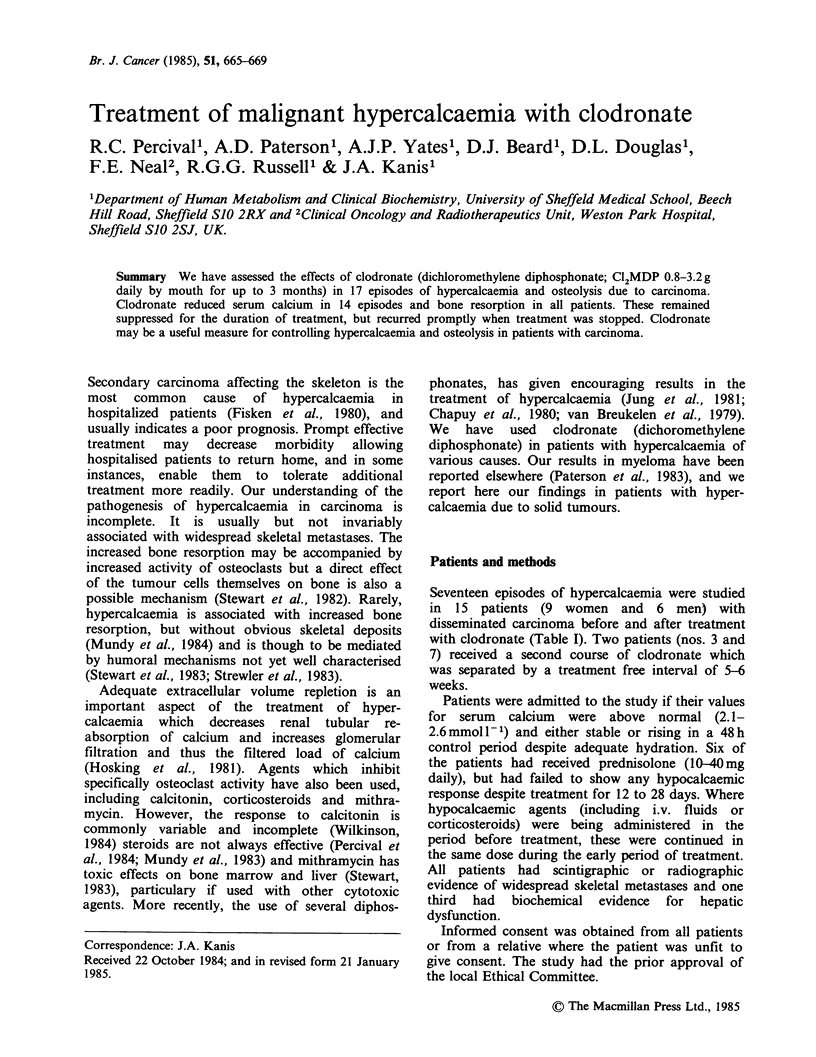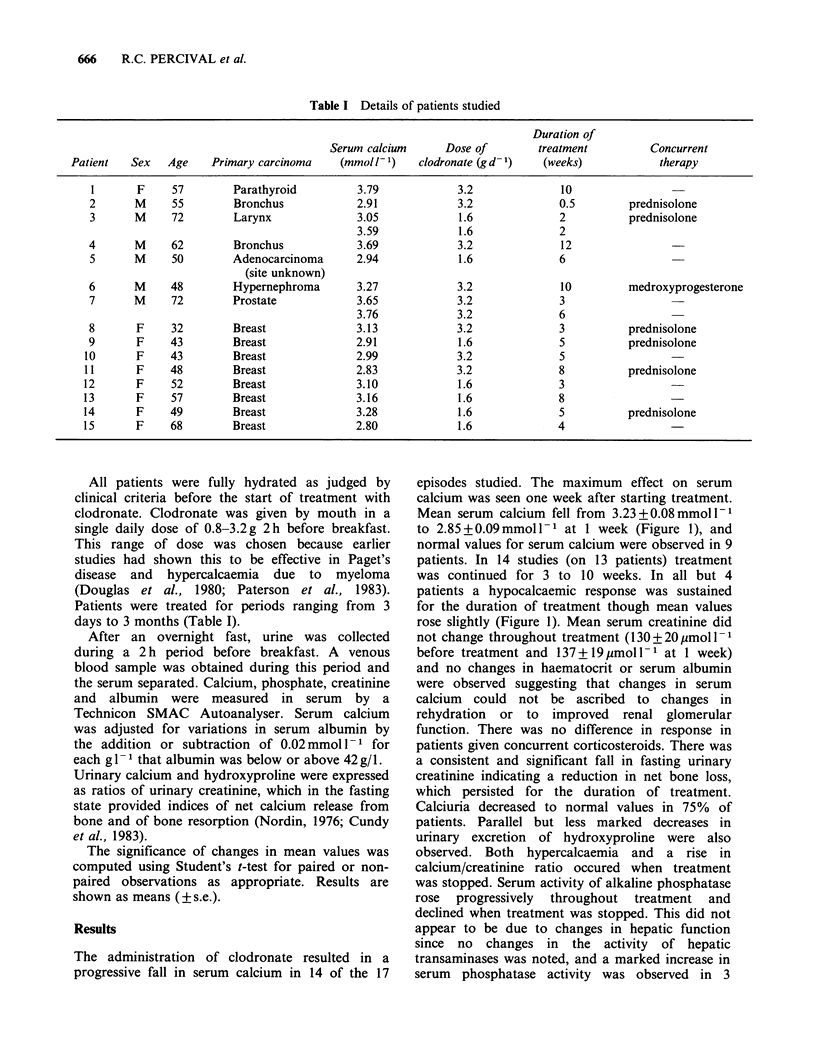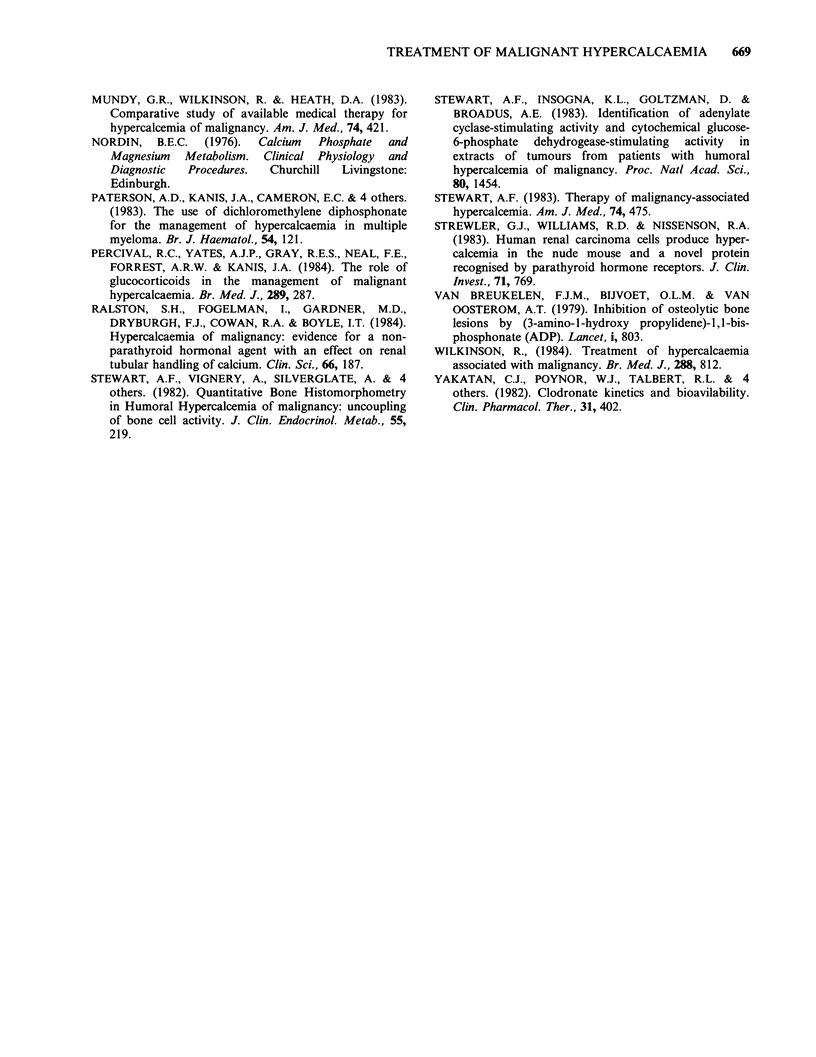Abstract
We have assessed the effects of clodronate (dichloromethylene diphosphonate; Cl2MDP 0.8-3.2g daily by mouth for up to 3 months) in 17 episodes of hypercalcaemia and osteolysis due to carcinoma. Clodronate reduced serum calcium in 14 episodes and bone resorption in all patients. These remained suppressed for the duration of treatment, but recurred promptly when treatment was stopped. Clodronate may be a useful measure for controlling hypercalcaemia and osteolysis in patients with carcinoma.
Full text
PDF




Selected References
These references are in PubMed. This may not be the complete list of references from this article.
- Boyce B. F., Smith L., Fogelman I., Johnston E., Ralston S., Boyle I. T. Focal osteomalacia due to low-dose diphosphonate therapy in Paget's disease. Lancet. 1984 Apr 14;1(8381):821–824. doi: 10.1016/s0140-6736(84)92272-4. [DOI] [PubMed] [Google Scholar]
- Chapuy M. C., Meunier P. J., Alexandre C. M., Vignon E. P. Effects of disodium dichloromethylene diphosphonate on hypercalcemia produced by bone metastases. J Clin Invest. 1980 May;65(5):1243–1247. doi: 10.1172/JCI109780. [DOI] [PMC free article] [PubMed] [Google Scholar]
- Cundy T., Bartlett M., Bishop M., Earnshaw M., Smith R., Kanis J. A. Plasma hydroxyproline in uremia: relationships with histologic and biological indices of bone turnover. Metab Bone Dis Relat Res. 1983;4(5):297–303. doi: 10.1016/s0221-8747(83)80003-4. [DOI] [PubMed] [Google Scholar]
- Douglas D. L., Duckworth T., Russell R. G., Kanis J. A., Preston C. J., Preston F. E., Prenton M. A., Woodhead J. S. Effect of dichloromethylene diphosphonate in Paget's disease of bone and in hypercalcaemia due to primary hyperparathyroidism or malignant disease. Lancet. 1980 May 17;1(8177):1043–1047. doi: 10.1016/s0140-6736(80)91496-8. [DOI] [PubMed] [Google Scholar]
- Elomaa I., Blomqvist C., Gröhn P., Porkka L., Kairento A. L., Selander K., Lamberg-Allardt C., Holmström T. Long-term controlled trial with diphosphonate in patients with osteolytic bone metastases. Lancet. 1983 Jan 22;1(8317):146–149. doi: 10.1016/s0140-6736(83)92755-1. [DOI] [PubMed] [Google Scholar]
- Fisken R. A., Heath D. A., Bold A. M. Hypercalcaemia--a hospital survey. Q J Med. 1980 Autumn;49(196):405–418. [PubMed] [Google Scholar]
- Hosking D. J., Cowley A., Bucknall C. A. Rehydration in the treatment of severe hypercalcaemia. Q J Med. 1981 Autumn;50(200):473–481. [PubMed] [Google Scholar]
- Jacobs T. P., Siris E. S., Bilezikian J. P., Baquiran D. C., Shane E., Canfield R. E. Hypercalcemia of malignancy: treatment with intravenous dichloromethylene diphosphonate. Ann Intern Med. 1981 Mar;94(3):312–316. doi: 10.7326/0003-4819-94-3-312. [DOI] [PubMed] [Google Scholar]
- Jung A., Chantraine A., Donath A., van Ouwenaller C., Turnill D., Mermillod B., Kitler M. E. Use of dichloromethylene diphosphonate in metastatic bone disease. N Engl J Med. 1983 Jun 23;308(25):1499–1501. doi: 10.1056/NEJM198306233082503. [DOI] [PubMed] [Google Scholar]
- Jung A., van Ouwenaller C., Chantraine A., Courvoisier B. Parenteral diphosphonates for treating malignant hypercalcemia. Cancer. 1981 Oct 15;48(8):1922–1925. doi: 10.1002/1097-0142(19811015)48:8<1922::aid-cncr2820480833>3.0.co;2-2. [DOI] [PubMed] [Google Scholar]
- Kanis J. A. Monitoring the treatment of Paget's disease with etidronate. Calcif Tissue Int. 1984 Dec;36(6):629–631. doi: 10.1007/BF02405380. [DOI] [PubMed] [Google Scholar]
- Kanis J. A., Preston C. J., Yates A. J., Percival R. C., Mundy K. I., Russell R. G. Effects of intravenous diphosphonates on renal function. Lancet. 1983 Jun 11;1(8337):1328–1328. doi: 10.1016/s0140-6736(83)92434-0. [DOI] [PubMed] [Google Scholar]
- Mundy G. R., Ibbotson K. J., D'Souza S. M., Simpson E. L., Jacobs J. W., Martin T. J. The hypercalcemia of cancer. Clinical implications and pathogenic mechanisms. N Engl J Med. 1984 Jun 28;310(26):1718–1727. doi: 10.1056/NEJM198406283102607. [DOI] [PubMed] [Google Scholar]
- Mundy G. R., Wilkinson R., Heath D. A. Comparative study of available medical therapy for hypercalcemia of malignancy. Am J Med. 1983 Mar;74(3):421–432. doi: 10.1016/0002-9343(83)90961-0. [DOI] [PubMed] [Google Scholar]
- Paterson A. D., Kanis J. A., Cameron E. C., Douglas D. L., Beard D. J., Preston F. E., Russell R. G. The use of dichloromethylene diphosphonate for the management of hypercalcaemia in multiple myeloma. Br J Haematol. 1983 May;54(1):121–132. doi: 10.1111/j.1365-2141.1983.tb02074.x. [DOI] [PubMed] [Google Scholar]
- Percival R. C., Yates A. J., Gray R. E., Neal F. E., Forrest A. R., Kanis J. A. Role of glucocorticoids in management of malignant hypercalcaemia. Br Med J (Clin Res Ed) 1984 Aug 4;289(6440):287–287. doi: 10.1136/bmj.289.6440.287. [DOI] [PMC free article] [PubMed] [Google Scholar]
- Ralston S. H., Fogelman I., Gardner M. D., Dryburgh F. J., Cowan R. A., Boyle I. T. Hypercalcaemia of malignancy: evidence for a nonparathyroid humoral agent with an effect on renal tubular handling of calcium. Clin Sci (Lond) 1984 Feb;66(2):187–191. doi: 10.1042/cs0660187. [DOI] [PubMed] [Google Scholar]
- Stewart A. F., Insogna K. L., Goltzman D., Broadus A. E. Identification of adenylate cyclase-stimulating activity and cytochemical glucose-6-phosphate dehydrogenase-stimulating activity in extracts of tumors from patients with humoral hypercalcemia of malignancy. Proc Natl Acad Sci U S A. 1983 Mar;80(5):1454–1458. doi: 10.1073/pnas.80.5.1454. [DOI] [PMC free article] [PubMed] [Google Scholar]
- Stewart A. F. Therapy of malignancy-associated hypercalcemia: 1983. Am J Med. 1983 Mar;74(3):475–480. doi: 10.1016/0002-9343(83)90985-3. [DOI] [PubMed] [Google Scholar]
- Stewart A. F., Vignery A., Silverglate A., Ravin N. D., LiVolsi V., Broadus A. E., Baron R. Quantitative bone histomorphometry in humoral hypercalcemia of malignancy: uncoupling of bone cell activity. J Clin Endocrinol Metab. 1982 Aug;55(2):219–227. doi: 10.1210/jcem-55-2-219. [DOI] [PubMed] [Google Scholar]
- Strewler G. J., Williams R. D., Nissenson R. A. Human renal carcinoma cells produce hypercalcemia in the nude mouse and a novel protein recognized by parathyroid hormone receptors. J Clin Invest. 1983 Mar;71(3):769–774. doi: 10.1172/JCI110825. [DOI] [PMC free article] [PubMed] [Google Scholar]
- Wilkinson R. Treatment of hypercalcaemia associated with malignancy. Br Med J (Clin Res Ed) 1984 Mar 17;288(6420):812–813. doi: 10.1136/bmj.288.6420.812. [DOI] [PMC free article] [PubMed] [Google Scholar]
- Yakatan G. J., Poynor W. J., Talbert R. L., Floyd B. F., Slough C. L., Ampulski R. S., Benedict J. J. Clodronate kinetics and bioavailability. Clin Pharmacol Ther. 1982 Mar;31(3):402–410. doi: 10.1038/clpt.1982.51. [DOI] [PubMed] [Google Scholar]
- van Breukelen F. J., Bijvoet O. L., van Oosterom A. T. Inhibition of osteolytic bone lesions by (3-amino-1-hydroxypropylidene)-1, 1-bisphosphonate (A.P.D.). Lancet. 1979 Apr 14;1(8120):803–805. doi: 10.1016/s0140-6736(79)91319-9. [DOI] [PubMed] [Google Scholar]


